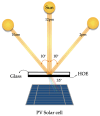Photopolymer Holographic Lenses for Solar Energy Applications: A Review
- PMID: 38543337
- PMCID: PMC10974481
- DOI: 10.3390/polym16060732
Photopolymer Holographic Lenses for Solar Energy Applications: A Review
Abstract
Holographic lenses (HLs) are part of holographic optical elements (HOE), and are being applied to concentrate solar energy on a focal point or focal line. In this way, the concentrated energy can be converted into electrical or thermal energy by means of a photovoltaic cell or a thermal absorber tube. HLs are able to passively track the apparent motion of the sun with a high acceptance angle, allowing tracking motors to be replaced, thus reducing the cost of support structures. This article focuses on a review of the materials used in the recording of a holographic lens (HL) or multiple HLs in photovoltaic and/or concentrating solar collectors. This review shows that the use of photopolymers for the recording of HLs enables high-performance efficiency in physical systems designed for energy transformation, and presents some important elements to be taken into account for future designs, especially those related to the characteristics of the HL recording materials. Finally, the article outlines future recommendations, emphasizing potential research opportunities and challenges for researchers entering the field of HL-based concentrating solar photovoltaic and/or concentrating solar thermal collectors.
Keywords: electrical energy; holographic lenses; photopolymers; solar energy; thermal energy.
Conflict of interest statement
The authors declare no conflicts of interest.
Figures














References
-
- Raimi D., Campbell E., Newell R., Prest B., Villanueva S., Wingenroth J. Global Energy Outlook 2022: Turning Points and Tension in the Energy Transition. Resources for the Future; Washington, DC, USA: 2022.
-
- Merchán R., Santos M., Medina A., Hernández A.C. High temperature central tower plants for concentrated solar power: 2021 overview. Renew. Sustain. Energy Rev. 2022;155:111828. doi: 10.1016/j.rser.2021.111828. - DOI
-
- Noč L., Jerman I. Review of the spectrally selective (CSP) absorber coatings, suitable for use in SHIP. Sol. Energy Mater. Sol. Cells. 2022;238:111625. doi: 10.1016/j.solmat.2022.111625. - DOI
-
- Hafez A., Soliman A., El-Metwally K., Ismail I. Design analysis factors and specifications of solar dish technologies for different systems and applications. Renew. Sustain. Energy Rev. 2017;67:1019–1036. doi: 10.1016/j.rser.2016.09.077. - DOI
-
- Otanicar T., DeJarnette D. Solar Energy Harvesting: How to Generate Thermal and Electric Power Simultaneously. SPIE Press; Bellingham, WA, USA: 2016.
Publication types
Grants and funding
LinkOut - more resources
Full Text Sources

